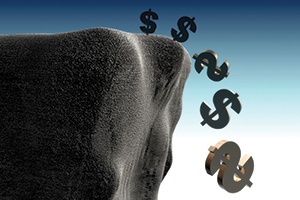 It was September 29, 2008, when the Dow Jones Industrial Average suffered what is now its second-largest point decline ever: it dropped 777.68 points during the day, after Congress’s rejection of the bank bailout bill. (Nearly 10 years later—on February 5, 2018—it closed down 1,175.21 points.) As bad as these declines were, however, they don't win the prize for the worst day ever in percentage terms. That would be October 19, 1987 (i.e., Black Monday), when the Dow lost 22.6 percent of its value. If we translate that into 2008 terms, the equivalent loss would be more than 2,500 points—or more than three times worse than the 2008 decline.
It was September 29, 2008, when the Dow Jones Industrial Average suffered what is now its second-largest point decline ever: it dropped 777.68 points during the day, after Congress’s rejection of the bank bailout bill. (Nearly 10 years later—on February 5, 2018—it closed down 1,175.21 points.) As bad as these declines were, however, they don't win the prize for the worst day ever in percentage terms. That would be October 19, 1987 (i.e., Black Monday), when the Dow lost 22.6 percent of its value. If we translate that into 2008 terms, the equivalent loss would be more than 2,500 points—or more than three times worse than the 2008 decline.
The bad days of 2008
Those were bad days, but 2008 got even worse. It was wrapped in a bad six months that saw a decline of 41.8 percent in the S&P 500 from September 2008 through February 2009. The total decline, from peak to trough, was even worse. The market took more than five years to reach a new high, in early 2013. Here, the contrast with 1987 is stark. Yes, the initial shock was considerably worse. But it took less than two years for the market to recover from the 1987 drop, not five.
These different experiences highlight what has to be considered when we look at financial market downturns or, to give them a scarier name, market crashes. There are two major metrics to consider: depth of the decline and recovery time. They are not necessarily the same, and the effects on your portfolio can be very different.
Depth of the decline and recovery time
Of course, 1987 and 2008 are legend. But what about 2000–2001? In that case, the Dow went from a peak of more than 11,700 to a bottom of 7,500 in September 2002—a decline of about 36 percent. It then took almost exactly four years to recover to new highs. Four years and five years seem to be typical of the two serious bear markets we have lived through in the past couple of decades. 1987, with a two-year recovery, seems like a best case.
For smaller declines, the recovery periods are much shorter. The pullback at the start of this year was just under 12 percent, and the market bounced back to new highs in a couple of months. The pullbacks from mid-2015 to the start of 2016 totaled more than 12 percent, but they were erased in just over a year. The pullback in 2011, of just under 16 percent, took less than a year to recover from. And from the pullback in mid-2010, of just under 14 percent, it took about seven months to bounce back.
What about the next 10 years?
From where we sit now, 10 years after the drop of 2008, we can draw a couple of conclusions about what the markets are likely to do over the next decade. First, we are likely to have a bear market in the next couple of years. Over the past 50 years, bear markets have tended to come roughly every 10 years or so: 1968, 1973, 1980, 1987, 2000, and 2008. It has now been 10 years since the last one. Drawdowns during those bear markets, in the S&P 500, have been between 27 percent (in 1980) and 57 percent (2008), so the next pullback is also likely to be substantial.
It’s not just timing either. Many economic and market conditions are very similar to what we have seen prior to previous downturns, with consumer confidence (for example) now at the highest level since 2000. Based on history, we can certainly expect another significant bear market sometime in the reasonably near future.
After that, however, we can also reasonably expect a sustained recovery in both the economy and the financial markets. While there will certainly be periodic pullbacks, as we have seen, they will likely be short lived and lead to further highs.
The real lesson
As investors, we need to be mindful of both the shorter-term risks and the longer-term opportunities, and position ourselves accordingly. That, 10 years on, is the real lesson of the financial crisis. Bear markets happen, in reasonably predictable ways, and need to be steered around. Shorter-term pullbacks also happen but can reasonably be ridden out. Looking back at history, but relying on fundamentals, is the best way to do both.


 Print
Print

